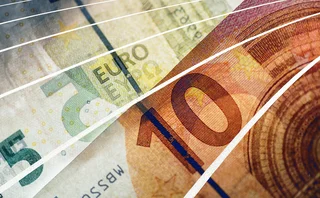
Hedge clipping
Burgeoning yields on lower-rated credits have lured many hedge funds into increasing their exposure to credit. David Watts looks at the various methods and tactics employed by hedge funds when investing in credit and credit derivatives
Activity in the credit markets by hedge funds has seen an explosion in recent months. According to Sanjay Tikku, a specialist in fixed-income hedge funds at Tremont, a firm that monitors and invests in hedge funds: “At least 10 hedge funds that invest purely in credit have opened in the past six months alone.”
The proliferation of these funds has been helped by the development of new credit products and the continuing expansion of the credit default swap market, paving the way for more credit trading. However, according to hedge fund managers, the real spur has been the remarkable turnaround in credit yields, especially in the lower-rated areas. For example, according to Lehman Borthers, US triple-B industrial borrowers have yielded 8.4% in the year to October 22, or 7.1% more than US Treasuries. Over the same period last year it yielded just 1.9%, or 7% less than US Treasuries.
And while hedge funds have the advantage of being able to go short, it is not always practical (or cheap) to short entire sectors when the market is as diversified as the US corporate bond market. New products that allow investors to trade exposure to the whole credit market via default swaps have only become widely accepted and sufficiently liquid this year.
Tikku at Tremont says: “These funds have started precisely to be in a position to benefit from the change in the market.” According to Tremont, there is an estimated $650–$700 billion in hedge funds, although the amount of money invested in credit is impossible to estimate. Many of the strategies that include credit exposure, such as debt-equity capital structure arbitrage and convertible arbitrage, will take varying exposures to credit depending on the environment.
Additionally, the real problem with understanding hedge funds’ credit strategies is that fund managers make their money by appearing to understand the market better than ordinary investors. This means the fund managers have a vested interest in keeping their methods to themselves and making their work seem more complicated than it really is.
However, the truth is that generally the credit strategies employed by hedge funds need not be very scientific. As one US-based distressed debt hedge fund manager says: “We are analysts, not technical traders.”
Unlike the interest rate, equity or foreign exchange markets, corporate bonds and other credit products are illiquid and inefficient. The credit markets are fragmented by investor type, maturity of bonds, ratings, and other factors, all of which creates potentially rich pickings for hedge funds.
John Botti, head of Crédit Lyonnais Credit Management, says: “The difference between high double-B and low triple-B is still very large because players in the investment grade area haven’t yet or cannot cross over to double-B.” Botti expects this difference to shrink over time as credit quality improves. “Between 1992 and 1997 ‘crossover’ meant upgrades. Between 1997 and today crossover has meant fallen angels. I think from 2004 crossover will once again mean rising stars as the economy improves.”
However, after almost a year of tightening investment-grade credit spreads, hedge funds are now looking to ‘pair trades’ to continue to make excess returns without needing to worry about the overall direction of the credit market.
As Botti says: “Pair trades have become more important – going long one credit and short another that is generically comparable.”
However, long-short strategies are somewhat different from those originally devised in the equity market. In credit, long-short often looks to reduce market or sector risk rather than make double the profits. As Mark Poole, chief investment officer of Blue Bay, one of Europe’s largest pure credit hedge funds, says: “A lot of pair trades are just directional trades dressed up as relative value.”
In the distressed debt market, hedge funds continue to find rich seams of profit by arbitraging the inconsistencies within a company’s assets. And new strategies are being devised that capitalize on the development of new credit derivative-based products – trading the correlation between defaults and the overall volatility of credit.
| 1. Credit risk Directional trade • Example: the classic directional trade is for hedge funds to focus on the credits in the crossover space – low triple-B and high double-B. With potential fallen angels or rising stars, hedge fund managers can exploit the forced selling and forced buying that real-money institutional investors are bound to in their mandates. • Theory: this involves the basics of credit analysis without all the restrictions that hinder benchmarked real-money investors. • Neutralizes: While taking directional bets is at the heart of all investing, it is also what many credit hedge funds have been focusing on over the past year. Directional bets are usually made within a broader long-short style portfolio. So while individual bets may not be hedged or partially hedged, the portfolio is likely to be roughly market neutral. Pair trades •Example: buy GM, sell Ford. •Theory: GM is undervalued versus Ford, however while the market and sector risks have been removed, both trades could still be wrong and end up damaging performance. •Neutralizes: |
| 2. Default / recovery risk Covenants/structural subordination Rather than attempt to catch the falling knife, investors will look to hedge their exposure to companies that look in danger of falling into difficulty. • Example: go long Bombardier Capital bonds and go short Bombardier Inc. The Bombardier Capital bonds have better covenants. • Theory: if Bombardier’s bonds recover, the long and the short should cancel each other out. If the company defaults, the better covenants on Bombardier Capital mean that a better recovery value is likely. • Neutralizes: Curve •Theory: according to Louis Gargour, senior fund manager at Rab Capital, a London-based credit hedge fund: “Distressed companies rarely languish, they either go bust or recover. Because short-dated is generally perceived as less risky it usually trades above the long-dated. If the company goes bust, you lose a little on the long and gain a lot on the short. If the company recovers, you lose a little on the short and gain a lot on the long.” • Neutralizes: |
| 3. Currency risk • Example: Buy dollar debt on Levi's and sell euro-denominated debt. • Theory: because the US corporate bond market is more liquid and there is a greater diversity in the investor base, when companies are affected by either positive or negative headline news, it will prompt a less exaggerated response in the dollar market than in euros. • Neutralizes: |
| 4. Credit volatility • Example: buy exposure to the credit market using a basket-linked note, such as Trac-x or iBoxx. If the fund believes volatility will be high, it will buy both a three- or six-month call and a put option on the index at today's price. • Theory: an option is worth the amount past the strike price that the underlying asset moves. So, if the market goes up or down by a lot, the value of one option increases by a lot - the other becomes worthless. In theory, high enough volatility will mean that the value of one of the options is greater than the cost of buying the original two options. Note, the problem with trading the volatility in credit is that no measure yet exists for it, unlike in the equity markets where investors can look to the Vixx as a measure of credit. |
| 5. Correlation between defaults Correlation trading • Example - buy the most junior tranche within a collateralized debt obligation or tranched basket-linked note, such as Trac-x or iBoxx. If the correlation between defaults increases, the value of the investment increases. • Theory: if correlation between default increases, the value of the lowest tranche increases. Since one default is sufficient to wipe out the lowest tranche in a collateralized debt obligation, the investor does not mind. |
| 6. Capital structure arbitrage A debt and equity strategy that exploits the differences in the pricing of the two markets. • Example: buy bonds in Distressed Debt Inc. and sell the equity in the same company. • Theory: Distressed debt companies are usually oversold, especially in Europe where the distressed debt investor base is smaller. If the company goes through Chapter 11 or into liquidation, the bonds will have some recovery value and the equity will go to zero. If the company recovers, the equity short can be removed and the bonds will appreciate. • Neutralizes: |
| 7. Convertible arbitrage In reality this is either a long-only credit strategy or a credit neutral because of the difficulty in short-selling convertibles. • Example: buy a convertible bond and short the underlying equity. • Theory: a convertible is a bond with an option to buy equity. When the equity market is volatile this option becomes more valuable because it is more likely to be exercised. The hedge fund will also short-sell the equity to hedge the exposure from the equity option. Hedge funds have continued to make money with a convertible arbitrage strategy in 2003 largely because of the tightening in credit spreads. Because volatility in the equity market has been low – the Vixx is around 20 – the strategy has really become a long credit one. |
Only users who have a paid subscription or are part of a corporate subscription are able to print or copy content.
To access these options, along with all other subscription benefits, please contact info@risk.net or view our subscription options here: http://subscriptions.risk.net/subscribe
You are currently unable to print this content. Please contact info@risk.net to find out more.
You are currently unable to copy this content. Please contact info@risk.net to find out more.
Copyright Infopro Digital Limited. All rights reserved.
You may share this content using our article tools. Printing this content is for the sole use of the Authorised User (named subscriber), as outlined in our terms and conditions - https://www.infopro-insight.com/terms-conditions/insight-subscriptions/
If you would like to purchase additional rights please email info@risk.net
Copyright Infopro Digital Limited. All rights reserved.
You may share this content using our article tools. Copying this content is for the sole use of the Authorised User (named subscriber), as outlined in our terms and conditions - https://www.infopro-insight.com/terms-conditions/insight-subscriptions/
If you would like to purchase additional rights please email info@risk.net
More on Markets
Rethinking P&L attribution for options
A buy-side perspective on how to decompose the P&L of index options is presented
Buy side would welcome more guidance on managing margin calls
FSB report calls for regulators to review existing standards for non-bank liquidity management
Citi halves swaptions book with US retail funds
Counterparty Radar: Mutual funds and ETFs cut exposures by 22% in Q4
Who’s winning the €STR futures race? Depends how you measure
CME, Eurex and Ice all claim to be leading, but experts say it’s too early to pick a winner
CDS review seeks to tackle conflicts ‘elephant’
Isda AGM: Linklaters proposes overhaul for determinations committee - including independent members
Saudi Arabia poised to become clean netting jurisdiction
Isda AGM: Netting regulation awaiting final approvals from regulators
Buy side looks to fill talent gap in yen rates trading
Isda AGM: Japan rate rises spark demand for traders; dealers say inexperience could trigger volatility
JP Morgan’s new way to trade FX overlays
Hybrid execution method allows clients to put dealers in competition via a single trading agreement







